Canyoneering in Death Valley
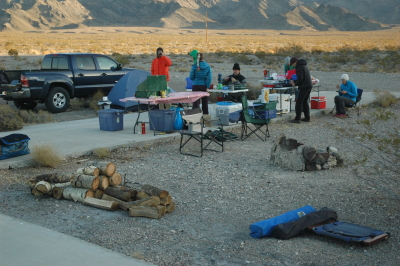
This past Thanksgiving weekend I joined some caving and canyoneering friends in Death Valley to celebrate the holiday in the great outdoors as well as explore some of the park’s more inaccessible canyons. We did not camp in the park, since campfires are not allowed and the park has a size limit for groups. Instead, we camped on BLM land just outside the park, in what appeared to be an abandoned RV trailer park that canyoneerers call Slabby Acres.
First a primer. Regular readers will know that I have been doing cave exploration and mapping now for about thirty years. This recreational activity not only involves knowing how to use survey instruments in a cave, you need also to be trained in the vertical rope techniques required to reach some remote places underground, sometimes dropping multiple pits on the way in and climbing those same domes on the way out.
Canyoneering is somewhat similar to caving. Just like caving you need to know how to travel over boulders and rough terrain and also know how to rappel and climb ropes. Unlike caving the canyons are open to the sky, and you rarely climb the ropes to travel up the canyon. In canyoneering the goal is to find the head of the canyon and travel down its many drops to come out at the bottom safely, all the while getting to see some wild, majestic, and rarely seen places. In addition, modern canyoneering rarely involves virgin exploration. Most canyoneerers visit already explored canyons whose details are well documented so that they know what ropes to bring as well as how to find the canyons.
This was our goal this past weekend. Some of the western cavers who have joined my survey projects and learned how to cave survey are also active canyoneerers. While none of us had ever visited the canyons on our trip list, several were very experienced with finding and traversing places they had never been before. My plan was to follow them and enjoy the experience. Below are my pictures during one of this weekend’s canyoneering trips. The canyon is Scorpion Canyon. It was the first we visited and was relatively easy to do, only 4.6 miles long with only six rappels and only an 1,800 foot elevation drop. It would take us over one of the mountain ranges that form the eastern wall of Death Valley. In fact, this was how I was going to enter Death Valley for the first time. Rather than drive in, like most tourists, I would rappel in.
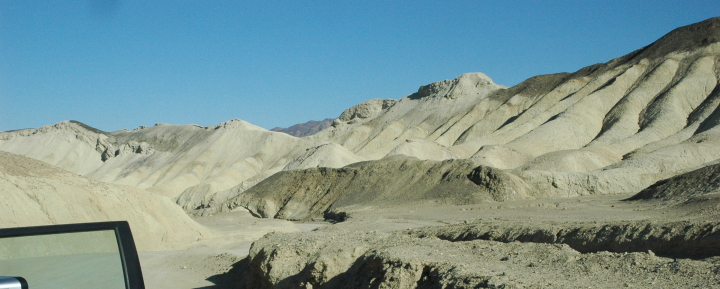
First we needed to set up the car shuttle. We dropped everyone off at the trail head, shown in the image above, while three people drove to the nearest parking area at the bottom of the canyon. There they would leave several cars and drive back. I and John SeJerman meanwhile would begin hiking up into the hills, since I was generally the slowest hiker. (Most of the people on this trip were 20 to 35 years younger than I was, so there was no way I could keep up with their pace, especially uphill. To save time, I generally would try to head out before them so that they would not have to wait for me.)
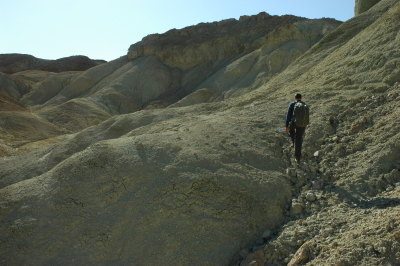
John led the way, as he had a GPS unit with the hiking track that would take us to the canyon head. Though most of canyoneering is downhill, you often have to travel quite a distance uphill to get to the top of the canyon. In this case we only needed to gain about 800 feet elevation on what was relatively easy though very barren and strange terrain. In fact, it was astonishing how little vegetation existed on this hike and in this particular canyon. For most of the trip the ground was devoid of plant and insect life. I could have almost been exploring Gale Crater with Curiosity, except that the gravity was too high and the geology was in many ways fundamentally different.
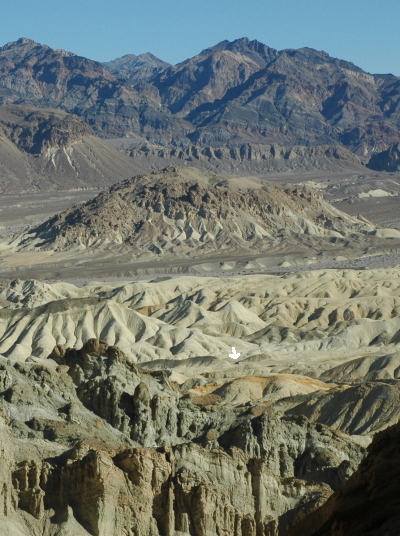
On the left is the view looking back once we reached the top of the mountain range. The white arrow indicates a vehicle driving on the road. John and I then topped the range and headed downhill to the west toward Death Valley, walking in a wide and open wash which steadily got narrower and narrower until it ended at 45 foot drop. Here we sat down, rigged the rope to a cairn anchor that someone had built previously, ate lunch, and waited for the others to catch up. It didn’t take them long, and soon we were on our way.
I should say a little about the rigging. Do not try this if you have not been trained by knowledgeable people. In Death Valley you are not allowed to drill holes to install bolts. Since the water that washes through these canyons tends to smooth the walls and eliminate any natural anchors, what canyoneerers do is create what they call cairn anchors. They tie a loop of webbing to a large rock and then literally pile bigger rocks on top of this to hold everything down.
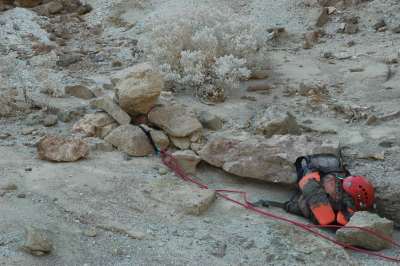
On the right is the cairn anchor for our first drop. It had been built by other canyoneerers on previous trips. All we had to do was check the webbing (which was still good), and rig our rope to it.
Let me repeat this: Do not do this on your own. Cairn anchors are safe, but only if they are built properly. Before we left on this particular trip we all had gotten together in a canyon near Tucson and practiced building cairn anchors and testing them. We had not known if we would find any already-built cairns in any of the canyons we planned to visit, and if not we knew we needed to know how to build them safely. This knowledge would then allow us to judge the safety of any cairns we might find once there.
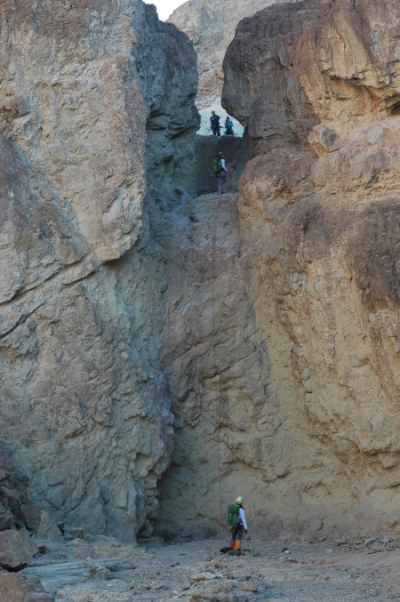
Anyway, this cairn anchor was safe, as were all the anchors we found during this trip. Only a few times did we need to make any improvements, and those changes usually involved replacing old webbing or the screwlink.
Once we had descended the first drop the nature of the canyon changed. Beforehand it had been a wide wash, open to the sky, with a scattering of scrub bushes. Below this first drop, shown on the right, the canyon became a narrow winding slot with absolutely no plant life.The high canyon walls meant that we were rarely in sunlight. It was mid-day by this time, and the temperature had warmed to the low seventies, but in the shaded canyon I would guess that the temperature never rose above 65 degrees. To keep warm I never removed my flannel shirt.
The walking was however easy, with relatively little boulder hopping. Interestingly, of the four canyons we visited during our three days in Death Valley, all were similar in this way. While their overall sizes varied — from the smallest, Scorpion, to the most monumental, Bad Canyon — they each had long stretches of flat, cobble washed floors where the walking was easy. This contrasted starkly with the canyons I have visited in the Tucson area, all of which had been filled with many giant cobble boulders that required you to scramble over, under, and between them.

The image above, of Belinda Norby in Scorpion Canyon, will give you a sense of what it was like to walk down this canyon.
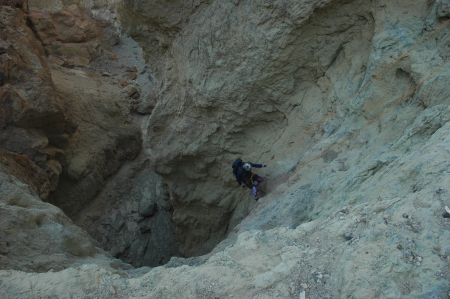
To the left is an image of Kevin Franke rappeling into one of the later drops. For this canyon I think the longest drop was 150 feet. Generally they were much less. Because Belinda and Kevin and the others were very experienced canyoneerers, we moved quickly from drop to drop, rigging quickly, rappeling, pulling our rope down, stuffing it in a rope bag, and moving on to the next drop.
I will admit that age has its privileges. Though I am a very experienced vertical caver and understood all the rigging that they were doing, I am also a relatively inexperienced canyoneerer. And because I couldn’t hike as fast as everyone else, they were glad to do the rigging and let me move on to enjoy the view while saving time. Thus, I had the pleasure of doing the canyon while all these “youngsters” did the work. For that I thank them.
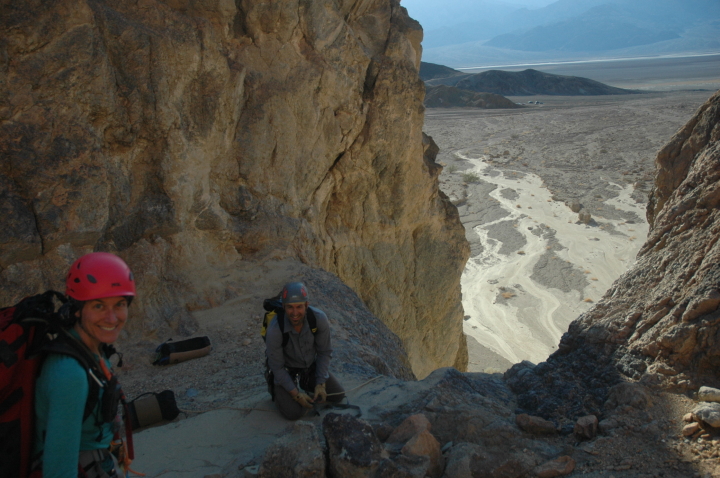
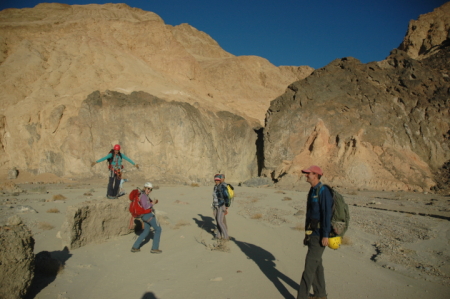
Above is an image of Belinda Norby and Pete London at the top of the last drop, rigging the rope to the cairn anchor there. Beyond them you can see Death Valley and the parking lot where we had staged two vehicles for the ride back to camp. This was actually the first good view I had ever had of Death Valley, and I must say that you really can’t beat this as a first approach.
To the right is some of our gang, with the vertical crack from which Scorpion Canyon exits behind us. At this point we had dropped a little more than 1,700 feet in elevation, and were still about 80 feet above sea level. The image below shows us hiking down to the cars, which were parked at approximately -200 feet elevation. We ourselves would drop below sea level after another 300 feet of hiking downhill.
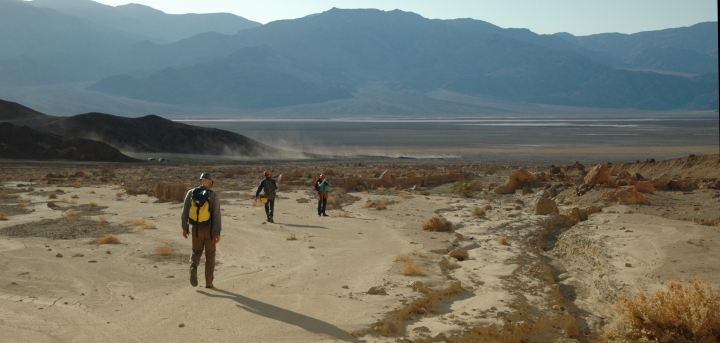
The other canyons were equally as interesting. For example, Bad Canyon, which we did the next day, started at about 5,500 feet elevation and took us down about 6,000 feet to Badwater, the lowest point in North America. This canyon was big in every way, though the walking was once again quite pleasant and the drops were all easy. I did not take my camera because the description of the bushwhack to get to the canyon from the top of the mountain made it seem like a difficult hike. I did not want to trash my camera doing it. In the end it was easier than expected.
Overall the weekend was spectacular and a lot of fun. I’d do it again in an instant, though I must admit that I still prefer the bigger sense of exploration I get when I go caving.
On Christmas Eve 1968 three Americans became the first humans to visit another world. What they did to celebrate was unexpected and profound, and will be remembered throughout all human history. Genesis: the Story of Apollo 8, Robert Zimmerman's classic history of humanity's first journey to another world, tells that story, and it is now available as both an ebook and an audiobook, both with a foreword by Valerie Anders and a new introduction by Robert Zimmerman.
The ebook is available everywhere for $5.99 (before discount) at amazon, or direct from my ebook publisher, ebookit. If you buy it from ebookit you don't support the big tech companies and the author gets a bigger cut much sooner.
The audiobook is also available at all these vendors, and is also free with a 30-day trial membership to Audible.
"Not simply about one mission, [Genesis] is also the history of America's quest for the moon... Zimmerman has done a masterful job of tying disparate events together into a solid account of one of America's greatest human triumphs."--San Antonio Express-News


After sitting at my computer for the past two years viewing, reading, understanding, arguing, discussing and explaining our political system I think I need a trip just like that, looks like a lot of fun.
Q: Was the presidential political result discussed at your frontier, Death Valley, Thanksgiving dinner? Or was such talk avoided?
Amazing landscape. Why is there so very little vegetation?
Teamwork, the outdoors and food. What else do you need?
Enjoyed the article Bob.
LocalFluff–
Others can probably explain it far better than I– (& please correct me if I’m wrong)
It’s a desert type of environment. There is a full blown desert to the South (the Mojave) & another desert type environment to the North. Very little rainfall, the hottest & driest place in the USA. The geography is such that the wet pacific air coming off the ocean drops as snow in the (California/Nevada) mountains long before any moisture makes it to this area.
If you go substantially further East, then you eventually run into a Prairie type environment with lots of grassland & substantially more moisture.
Awesome views! Thanks for sharing. I’m just a flat-lander. The highest hike I’ve hiked is 126 feet and it shrinks more and more every year. :(
Mount Baldy, Indiana
Great stuff, Robert. I’ve been to Death Valley and enjoyed it. I’ve had life-long love of the wild places; I just don’t want to walk to them.
Very cool blog, Bob! Thanks for writing this up – it’s great to have all this detail so we can revisit later :)
Carole: My only regret was that I didn’t get a good picture of either you or Josh, and thus didn’t mention your names in the post.
Is there a Life Valley? Better yet Afterlife Valley!
It looks like you had a fantastic time!! Thanks for sharing Bob!!
Well written Bob. Enjoyed reading.
Jennifer: I just realized I had no idea what your last name was! Twas a great trip. Must do it again.
Sounds like it was a lot of fun! I love Death Valley!
Love it, Bob! I’m glad you could come with us!